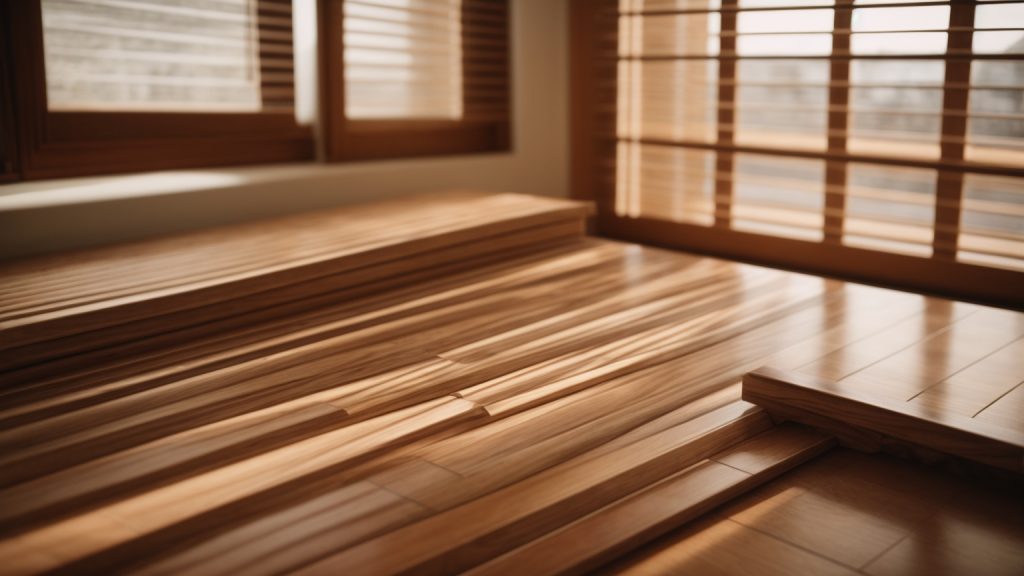Do you have wooden blinds that are too long for your window? Shortening them is a simple process that you can do yourself with just a few tools and some basic knowledge. In this article, we will provide step-by-step instructions on how to shorten your wooden blinds to fit your window perfectly.
Before you begin, it’s important to know that there are two types of wooden blinds: those with a cord and those with a wand. The process for shortening each type is slightly different, so make sure you know which type you have before you start. Once you have determined the type of blinds you have, you can follow the appropriate steps to shorten them. With a little patience and attention to detail, you can have your wooden blinds fitting perfectly in no time.
Understanding Wooden Blinds

Wooden blinds are a popular window treatment that can add warmth and style to any room. They are made of horizontal slats that can be adjusted to control the amount of light that enters the room. Wooden blinds are available in a variety of colors and finishes to match any decor.
When it comes to sizing, wooden blinds are typically made to fit standard window sizes. However, if your window is an odd size or shape, you may need to have your blinds custom made. It’s important to measure your window carefully to ensure that your blinds fit properly.
Wooden blinds are also available in different slat widths, ranging from 1 inch to 2 1/2 inches. The wider the slats, the more light they will let in when they are open. However, wider slats may also make the blinds heavier and harder to lift.
One thing to keep in mind when choosing wooden blinds is that they can be prone to warping in humid environments. If you live in a humid climate or plan to use your blinds in a bathroom or kitchen, you may want to consider faux wood blinds instead.
Overall, wooden blinds are a classic and versatile window treatment that can add beauty and functionality to any room in your home. With proper care and maintenance, they can last for many years to come.
Tools Needed for Shortening Wooden Blinds
When it comes to shortening wooden blinds, you will need a few tools to get the job done. Here are the essential tools you will need:
Measuring Tape
Before you start shortening your wooden blinds, you need to measure the length of the blinds and determine how much you need to shorten them. A measuring tape is an essential tool that will help you get accurate measurements.
Pencil
You will need a pencil to mark the spot where you need to cut the wooden blinds. Make sure the pencil is sharp so that you can make precise marks on the blinds.
Scissors
You will need a pair of scissors to cut the ladder strings of the wooden blinds. Make sure the scissors are sharp enough to cut through the strings easily.
Screwdriver
You will need a screwdriver to remove the end caps of the wooden blinds. This will allow you to remove the ladder strings and cut the blinds to the desired length.
With these tools in hand, you will be able to shorten your wooden blinds with ease. Just make sure to follow the instructions carefully and take your time to ensure that you get the job done right.
How to Measure Wooden Blinds for Shortening
If you have wooden blinds that are too long for your window, you can easily shorten them to fit. Before you begin, you’ll need to measure your blinds to determine how much to shorten them. Here’s how to do it:
- Measure the width of your window opening. This will give you the width measurement for your blinds. If you already have blinds installed, you can skip this step.
- Measure the length of your blinds. Use a measuring tape to measure the length of your blinds from the top of the headrail to the bottom of the slats.
- Determine how much you need to shorten your blinds. Subtract the desired length of your blinds from the current length. This will give you the amount you need to shorten your blinds.
- Decide where you want to make the cut. You can cut the slats themselves or the lift cords that hold the slats in place. If you cut the lift cords, be sure to tie a knot in the end to prevent the cords from slipping through the holes in the slats.
- Mark the spot where you want to make the cut. Use a pencil or a piece of tape to mark the spot where you want to cut your blinds.
- Double-check your measurements before making any cuts. Measure twice, cut once!
By following these simple steps, you can easily measure your wooden blinds for shortening. Once you’ve determined how much to shorten your blinds, you can move on to the next step of actually shortening them.
Marking the Desired Length

Shortening wooden blinds can be a simple and cost-effective way to update the look of your windows without having to replace the entire set of blinds. To begin, you’ll need to determine the desired length of your blinds.
- Measure the height of your window frame from the top to the bottom. This will give you an idea of how much length you need to remove from your blinds.
- Decide on the new length of your blinds. Keep in mind that you’ll need to mark the slat at or just below where the blind will stop, so make sure to account for the length of the bottom rail and any excess slats that may need to be removed.
- Mark the slat at the desired length. You can use a pencil or a piece of tape to mark the slat. Make sure the mark is clear and visible.
- Note which are the ladder strings and which are the lift strings. This will help you when it comes time to trim the strings.
- If you have multiple blinds, make sure to mark each one individually. This will help ensure that all of your blinds are the same length.
By following these steps, you can easily mark the desired length of your wooden blinds and prepare them for the next step in the shortening process.
Removing the Excess Slats
Shortening wooden blinds is a simple process that can be done at home with a few basic tools. One of the first steps to shortening your wooden blinds is to remove the excess slats. This is an important step because it will help you achieve the correct length for your blinds.
To remove the excess slats, you will need to follow these steps:
- First, lower your blinds all the way down so that you can easily access the bottom rail.
- Next, remove the end caps from the bottom rail, if they are already installed. This will allow you to slide out the slats in the bottom rail, exposing the inside of the rail.
- Select the slat that is even with or slightly below the window sill. This will be the new bottom slat.
- Remove the excess slats by cutting them with a pair of scissors or a saw. Be sure to cut the excess slats close to the bottom of the bottom rail.
- Once you have removed the excess slats, slide the bottom rail back into place and reattach the end caps.
By following these steps, you can easily remove the excess slats from your wooden blinds and achieve the correct length for your windows. Remember to measure twice and cut once to ensure that you shorten your blinds to the correct length.
Reassembling the Blinds
Now that you have shortened your wooden blinds, it’s time to reassemble them. Here are some steps to follow:
- First, make sure that all the slats are facing in the same direction. You can easily do this by laying them flat on a table or any other flat surface.
- Next, insert the lift cords back into the holes in the bottom rail. Make sure that they are properly aligned and that all the cords are in their respective holes.
- After that, insert the tilt rod back into the tilter mechanism. Make sure that it is properly aligned and that it moves smoothly.
- Now, reattach the end caps to the headrail. You can do this by sliding them into place and then tightening the screws with a screwdriver.
- Finally, reattach the valance clips to the headrail. Make sure that they are properly aligned and that they hold the valance securely in place.
Congratulations, you have successfully shortened and reassembled your wooden blinds! Now you can enjoy your new custom-fit window coverings.
Final Adjustments
Once you have shortened your wooden blinds to the desired length, you will need to make some final adjustments to ensure they are working properly. Here are some steps you can take to make sure your newly shortened blinds are functioning correctly:
- Check the slats: After shortening your blinds, the slats may be uneven. To fix this, gently adjust the slats with your hands until they are even and level with each other.
- Test the cords: Pull on the cords to make sure they are working properly. If the cords are too loose or too tight, adjust them as needed. Be careful not to overtighten the cords, as this can cause the blinds to become misaligned.
- Reattach the bottom rail plugs: Once you have adjusted the cords, reattach the bottom rail plugs. Make sure they are securely in place.
- Test the blinds: Test the blinds by raising and lowering them a few times. Make sure they are moving smoothly and evenly. If the blinds are still not working properly, you may need to make further adjustments.
By following these steps, you can ensure that your newly shortened wooden blinds are functioning properly and will provide you with years of use.
Safety Precautions While Shortening Wooden Blinds
Before you start shortening your wooden blinds, it is essential to take some safety precautions to prevent any injuries or damage to your property. Here are some safety tips to keep in mind:
1. Use Protective Gear
When shortening wooden blinds, you may need to use sharp tools such as scissors or pliers. To avoid injury, it is crucial to wear protective gear such as gloves and eye protection. Gloves will protect your hands from cuts, while eye protection will prevent any debris from getting into your eyes.
2. Keep Children and Pets Away
Shortening wooden blinds can be a hazardous task, and it is not recommended to let children or pets near the area. The tools used to shorten the blinds can be dangerous, and children or pets could accidentally hurt themselves.
3. Work in a Well-Lit Area
It is essential to work in a well-lit area when shortening wooden blinds. This will help you see what you are doing and prevent any accidents. If you are working in a dimly lit area, use a flashlight or work lamp to illuminate the workspace.
4. Follow the Manufacturer’s Instructions
Before shortening your wooden blinds, it is essential to read the manufacturer’s instructions carefully. This will help you understand the process and avoid any mistakes that could damage the blinds. If you are unsure about any step, contact the manufacturer for clarification.
By following these safety precautions, you can ensure that your wooden blinds are shortened correctly without any accidents. Remember, safety should always come first, and it is better to be safe than sorry.
